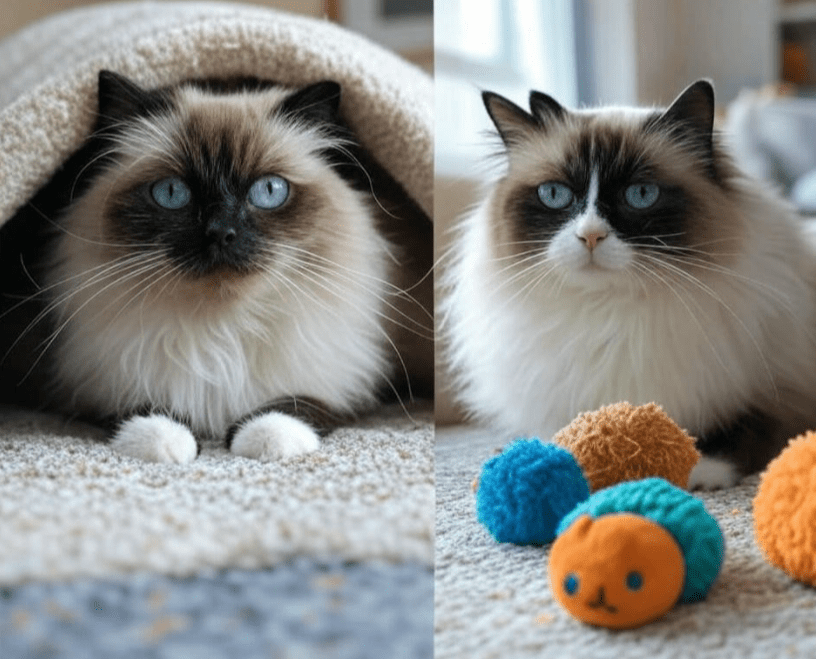
Ragdoll cats are known for their gentle temperament, striking blue eyes, and plush, silky coats. These affectionate felines often form deep bonds with their owners, making them excellent candidates for learning fun tricks like fetching. Teaching your Ragdoll cat to fetch not only strengthens your bond but also provides mental and physical stimulation. If you’re wondering how to train your Ragdoll cat to fetch like a pro, this comprehensive guide will walk you through every step, offering expert tips and insights to ensure success.
Why Teach Your Ragdoll Cat to Fetch?
Ragdolls are intelligent, social, and eager to please, traits that make them ideal for learning interactive games like fetch. Unlike some other cat breeds, Ragdolls often enjoy engaging with their humans in playful activities. Fetching offers several benefits:
Mental Stimulation: Fetch engages your cat’s problem-solving skills and keeps their mind sharp.
Physical Exercise: Running and chasing toys helps maintain a healthy weight and promotes agility.
Strengthened Bond: Training sessions foster trust and communication between you and your Ragdoll.
Fun and Entertainment: Fetch is an enjoyable activity for both you and your cat, adding variety to playtime.
With patience and the right approach, your Ragdoll can master fetching, turning playtime into a rewarding experience.
Understanding Your Ragdoll’s Unique Traits
Before diving into training, it’s essential to understand the characteristics that make Ragdolls special. These cats are often described as “puppy-like” due to their sociable and trainable nature. Here are some traits that influence their ability to learn fetch:

Docile Temperament: Ragdolls are calm and relaxed, which can make them more receptive to training.
Playful Curiosity: They enjoy exploring toys and games, especially when encouraged by their owners.
Affection-Driven: Ragdolls thrive on positive reinforcement and attention, making praise and treats effective motivators.
Moderate Energy Levels: While not as hyperactive as some breeds, Ragdolls enjoy short bursts of activity, perfect for fetch sessions.
By leveraging these traits, you can tailor your training approach to suit your Ragdoll’s personality and preferences.
Preparing for Fetch Training
Successful fetch training starts with preparation. Gather the right tools and create an environment conducive to learning. Here’s what you’ll need:
1. Choose the Right Toy
Selecting a toy your Ragdoll loves is critical. Ideal fetch toys include:
1.Small, lightweight balls (e.g., ping-pong balls or crinkle balls)
2.Soft, plush toys that are easy to carry
3.Toys with feathers or strings for added appeal
4.Avoid heavy or overly large toys that may be difficult for your cat to pick up.
Test different toys to see which one excites your Ragdoll the most. A toy they naturally chase or carry is a great starting point.
2. Stock Up on Treats
Positive reinforcement is key to training. Use high-value treats your Ragdoll loves, such as:
1.Freeze-dried chicken or fish
2.Small pieces of tuna
3.Commercial cat treats designed for training
Keep treats small to avoid overfeeding during sessions.
3. Create a Distraction-Free Environment
Choose a quiet, familiar space for training, such as a living room or bedroom. Remove distractions like other pets, loud noises, or competing toys to help your Ragdoll focus.
4. Set a Training Schedule
Consistency is crucial. Plan short, daily training sessions (5-10 minutes) to keep your cat engaged without overwhelming them. Ragdolls respond best to brief, fun sessions that end on a positive note.
Step-by-Step Guide to Teaching Your Ragdoll Cat to Fetch
Now that you’re prepared, follow these steps to teach your Ragdoll to fetch. Each step builds on the previous one, gradually introducing the components of fetching.
Step 1: Introduce the Toy
Start by getting your Ragdoll excited about the fetch toy. Here’s how:
1.Play with the toy yourself, tossing it gently or dragging it across the floor to spark curiosity.
2.Encourage your cat to chase or pounce on the toy.
3.Reward any interaction (e.g., touching, batting, or picking up the toy) with praise or a treat.
The goal is to associate the toy with fun and rewards.
Step 2: Encourage Picking Up the Toy
Fetching requires your cat to carry the toy in their mouth. To teach this:
1.Hold the toy near your Ragdoll’s mouth and reward them for sniffing or touching it with their lips.
2.If they pick up the toy, even briefly, offer a treat and enthusiastic praise.
3.Use a cue word like “fetch” or “take” each time they grab the toy to build an association.
Be patient—some Ragdolls may take time to feel comfortable carrying objects.
Step 3: Introduce the Toss
Once your cat is comfortable picking up the toy, add the tossing element:
1.Gently toss the toy a short distance (1-2 feet) and encourage your Ragdoll to chase it.
2.If they pick it up, call them back with an excited tone or use a treat to lure them.
3.Reward them generously when they return to you, even if they don’t bring the toy back yet.
Keep tosses short to maintain interest and avoid frustration.
Step 4: Teach the Return
The next step is getting your Ragdoll to bring the toy back to you:
1.After your cat picks up the tossed toy, crouch down and call them back using their name or a cue like “come.”
2.If they drop the toy before returning, pick it up and try again, rewarding small steps toward bringing it closer.
3.When they bring the toy back (even partway), reward them with treats and praise.
Gradually increase the distance they need to carry the toy to receive a reward.
Step 5: Combine All Steps
Now, put it all together:
1.Toss the toy a short distance.
2.Use your cue word (“fetch”) to encourage picking it up.
3.Call your Ragdoll back and reward them for returning with the toy.
4.If they drop the toy near you, praise them and toss it again to keep the game going.
Practice this sequence consistently, gradually increasing the tossing distance as your cat becomes more confident.
Step 6: Fade Out Treats

Once your Ragdoll reliably fetches, reduce treat rewards:
1.Replace treats with verbal praise, petting, or extra playtime.
2.Occasionally offer treats to maintain motivation, especially for longer fetch sessions.
3.The act of fetching should become its own reward as your cat enjoys the game.
Tips for Success
To ensure your Ragdoll masters fetching, keep these tips in mind:
Use Positive Reinforcement: Always reward progress, no matter how small, to build confidence.
Keep Sessions Short: Ragdolls have moderate attention spans, so aim for 5-10 minute sessions.
Be Patient: Every cat learns at their own pace. Avoid rushing or forcing your Ragdoll to perform.
Vary the Toys: Switch up fetch toys occasionally to maintain interest.
End on a High Note: Stop training sessions while your cat is still engaged and excited.
Observe Body Language: If your Ragdoll seems tired or disinterested, take a break and try again later.
Troubleshooting Common Challenges
Even with the best approach, you may encounter hurdles. Here’s how to address common issues:
Problem: My Ragdoll Won’t Chase the Toy
Solution: Try a different toy that sparks their interest, such as one with feathers or a crinkle sound. You can also rub a bit of catnip on the toy to make it more enticing.

Problem: My Cat Picks Up the Toy but Doesn’t Return
Solution: Use a second toy or treat to lure them back to you. Gradually reduce the lure as they learn to return on their own.
Problem: My Ragdoll Loses Interest Quickly
Solution: Shorten training sessions and ensure the environment is free of distractions. Increase the value of rewards (e.g., use their favorite treat) to boost motivation.
Problem: My Cat Drops the Toy Too Soon
Solution: Reward them for holding the toy longer before dropping it. Use a clicker or verbal marker (e.g., “yes!”) to pinpoint the moment they hold it correctly.
Advanced Fetch Training for Ragdolls
Once your Ragdoll masters basic fetching, you can take their skills to the next level:
Increase Distance: Gradually toss the toy farther, encouraging your cat to run longer distances.
Add Obstacles: Place low hurdles or tunnels for your Ragdoll to navigate while fetching.
Teach Multiple Toys: Train your cat to fetch specific toys by name (e.g., “ball” or “mouse”).
Incorporate Commands: Add cues like “drop it” to teach your cat to release the toy on command.
These advanced tricks keep your Ragdoll mentally stimulated and make fetch even more impressive.
The Role of Consistency and Bonding
Training your Ragdoll to fetch is as much about building a relationship as it is about teaching a skill. Ragdolls thrive on attention and trust, so use training as an opportunity to deepen your bond. Consistent training sessions, paired with love and patience, create a positive experience that your cat will look forward to.
Regular playtime also helps you understand your Ragdoll’s personality and preferences, allowing you to tailor activities to their unique needs. The more you invest in training, the stronger your connection will become.
Safety Considerations
While fetch is a safe and fun activity, keep these precautions in mind:
Choose Safe Toys: Avoid toys with small parts that could be swallowed or sharp edges that could cause injury.
Monitor Playtime: Prevent overexertion, especially for kittens or senior Ragdolls, by keeping sessions short.
Check for Wear: Inspect fetch toys regularly for damage and replace them if they become worn or frayed.
Supervise Training: Always supervise play to ensure your cat doesn’t ingest anything harmful or get tangled in strings.
Why Ragdolls Excel at Fetch
Ragdolls’ unique combination of intelligence, sociability, and playfulness makes them stand out as a breed that can excel at fetching. Unlike more independent breeds, Ragdolls often enjoy participating in activities that involve their owners. Their desire to please and love for interactive play makes them natural candidates for learning tricks like fetch.
By tapping into their instincts and using positive reinforcement, you can unlock your Ragdoll’s potential to fetch like a pro, creating memorable moments of joy and connection.
Conclusion

Teaching your Ragdoll cat to fetch is a rewarding journey that enhances your bond, provides exercise, and stimulates their mind. With the right tools, a consistent approach, and plenty of patience, your Ragdoll can learn to fetch like a pro. Start with small steps, celebrate progress, and keep training fun to ensure success. Whether you’re tossing a crinkle ball or a plush toy, the time you invest in training will pay off in countless hours of playful interaction.
Ready to get started? Grab your Ragdoll’s favorite toy, stock up on treats, and begin this exciting adventure today. Your Ragdoll is ready to shine as the ultimate fetch champion!




